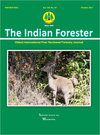Preliminary Study on Diversity of Insect Pollinators in Navdanya Organic Farm, Dehradun, Uttarakhand, India
DOI:
https://doi.org/10.36808/if/2017/v143i10/119361Keywords:
Biodiversity, Conservation, Organic Farm, Doon Valley, Pollination, Seed Bank.Abstract
Situated adjacent to Shivaliks, foot hills of the Himalaya, the Navdanya Organic Farm (40 acres; 30° 19'38.78"N, 77°52'30.83"E; 534 m asl) in Doon valley in the Uttarakhand state, India, is known for developing its own seed bank grown for nine crops that represent country's collective source of food security. The present communication reports a total of 19 insect pollinators belonging to five orders under 14 families from the farm during January to May, 2011, indicating rich insect pollinator diversity. The major pollinating species were Syrphid flies (Diptera: Syrphidae) (1521 individuals) followed by bees Apis mellifera (273) and Apis florae (121) (Hymenoptera: Apidae). Daucus carota (Carrot) had maximum number (19 species) of pollinating species, reaching a number of 852 individuals (36.4 % of the total) followed by Citrus aurantifolia (lemon) (12 species) and Matricaria chamomilla (chamomile (12 species). This study generates baseline information about diversity of insect pollinators in Doon valley in a managed organic farm like Navdanya.References
Beeson CFC. 1941. The ecology and control of forest insects of India and neighboring countries. Vasant press, Dehradun, Reprinted Government of India Publications. 1007 pp.
Eardley C., Roth D., Clarke J., Buchmann S. and Gemmill B. (2006). Pollinators and pollination: a resource book for policy and practice. Agricultural Research Council (ARC).
Gallai N., Salles J.M., Settele J. and Vaissiere B.E. (2009). Economic valuation of the vulnerability of world agriculture confronted with pollinator decline. Ecol. Econ., 68: 810 – 821.
Kehmikar I. (2008). The Book of Indian Butterflies. Bombay Natural History Society, Oxford University Press, Mumbai. 497 pp.
Klein A.M., Vaissière B., Cane J.H., Steffan D.I., Cunningham S.A., Kremen C. and Tscharntke T. (2007). Importance of pollinators in changing landscapes for world crops. Proceedings of the Royal Society, 274: 303–313.
Losey J.E. and Vaughan M. (2006). The economic value of ecological services provided by insects. BioScience, 56: 311–323.
Matheson A., Buchmann S.L., O'Toole C., Westrich P. and Williams I.H., (1996). The conservation of bees. Academic Press, Harcourt Brace, London.
Nabhan G.P. (1996). Global list of threatened vertebrate wildlife species serving as pollinators for crops and wild plants. Forgotten Pollinators Campaign, Arizona-Sonora Desert Museum, Tucson.
Rosemeire A.G., Rachel P.M. and Maria A.C. (2009). Bee diversity in a commercial Guava orchard in Salinas, Minas Gerais State, Brazil. Bragantia, 68(1): 23–27.
Tracy M. and Jessica S. (2015). The role of organic in supporting pollinator health. The Organic Center. www.organic-center.org.
Downloads
Downloads
Published
How to Cite
Issue
Section
License
Unless otherwise stated, copyright or similar rights in all materials presented on the site, including graphical images, are owned by Indian Forester.





